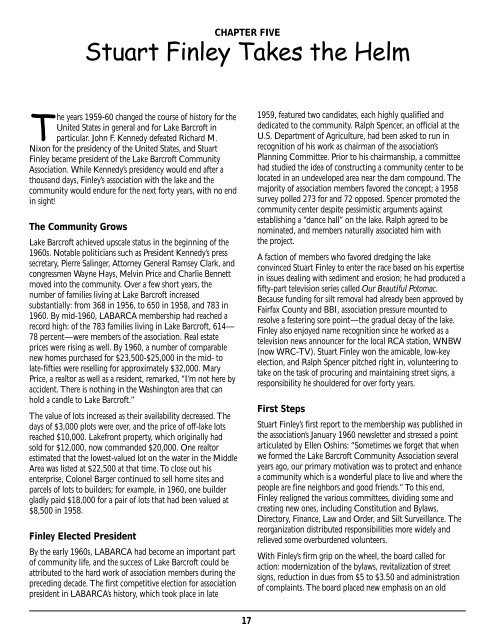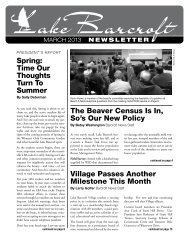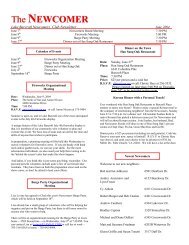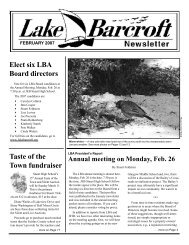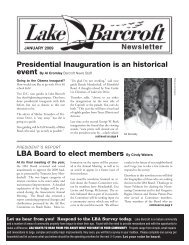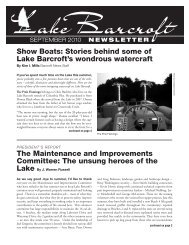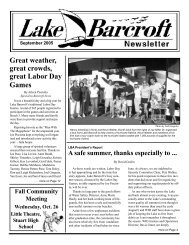Lake Barcroft History Book
Lake Barcroft History Book
Lake Barcroft History Book
Create successful ePaper yourself
Turn your PDF publications into a flip-book with our unique Google optimized e-Paper software.
The years 1959-60 changed the course of history for the<br />
United States in general and for <strong>Lake</strong> <strong>Barcroft</strong> in<br />
particular. John F. Kennedy defeated Richard M.<br />
Nixon for the presidency of the United States, and Stuart<br />
Finley became president of the <strong>Lake</strong> <strong>Barcroft</strong> Community<br />
Association. While Kennedy’s presidency would end after a<br />
thousand days, Finley’s association with the lake and the<br />
community would endure for the next forty years, with no end<br />
in sight!<br />
The Community Grows<br />
<strong>Lake</strong> <strong>Barcroft</strong> achieved upscale status in the beginning of the<br />
1960s. Notable politicians such as President Kennedy’s press<br />
secretary, Pierre Salinger, Attorney General Ramsey Clark, and<br />
congressmen Wayne Hays, Melvin Price and Charlie Bennett<br />
moved into the community. Over a few short years, the<br />
number of families living at <strong>Lake</strong> <strong>Barcroft</strong> increased<br />
substantially: from 368 in 1956, to 650 in 1958, and 783 in<br />
1960. By mid-1960, LABARCA membership had reached a<br />
record high: of the 783 families living in <strong>Lake</strong> <strong>Barcroft</strong>, 614—<br />
78 percent—were members of the association. Real estate<br />
prices were rising as well. By 1960, a number of comparable<br />
new homes purchased for $23,500-$25,000 in the mid- to<br />
late-fifties were reselling for approximately $32,000. Mary<br />
Price, a realtor as well as a resident, remarked, “I’m not here by<br />
accident. There is nothing in the Washington area that can<br />
hold a candle to <strong>Lake</strong> <strong>Barcroft</strong>.”<br />
The value of lots increased as their availability decreased. The<br />
days of $3,000 plots were over, and the price of off-lake lots<br />
reached $10,000. <strong>Lake</strong>front property, which originally had<br />
sold for $12,000, now commanded $20,000. One realtor<br />
estimated that the lowest-valued lot on the water in the Middle<br />
Area was listed at $22,500 at that time. To close out his<br />
enterprise, Colonel Barger continued to sell home sites and<br />
parcels of lots to builders; for example, in 1960, one builder<br />
gladly paid $18,000 for a pair of lots that had been valued at<br />
$8,500 in 1958.<br />
Finley Elected President<br />
CHAPTER FIVE<br />
Stuart Finley Takes the Helm<br />
By the early 1960s, LABARCA had become an important part<br />
of community life, and the success of <strong>Lake</strong> <strong>Barcroft</strong> could be<br />
attributed to the hard work of association members during the<br />
preceding decade. The first competitive election for association<br />
president in LABARCA’s history, which took place in late<br />
17<br />
1959, featured two candidates, each highly qualified and<br />
dedicated to the community. Ralph Spencer, an official at the<br />
U.S. Department of Agriculture, had been asked to run in<br />
recognition of his work as chairman of the association’s<br />
Planning Committee. Prior to his chairmanship, a committee<br />
had studied the idea of constructing a community center to be<br />
located in an undeveloped area near the dam compound. The<br />
majority of association members favored the concept; a 1958<br />
survey polled 273 for and 72 opposed. Spencer promoted the<br />
community center despite pessimistic arguments against<br />
establishing a “dance hall” on the lake. Ralph agreed to be<br />
nominated, and members naturally associated him with<br />
the project.<br />
A faction of members who favored dredging the lake<br />
convinced Stuart Finley to enter the race based on his expertise<br />
in issues dealing with sediment and erosion; he had produced a<br />
fifty-part television series called Our Beautiful Potomac.<br />
Because funding for silt removal had already been approved by<br />
Fairfax County and BBI, association pressure mounted to<br />
resolve a festering sore point—the gradual decay of the lake.<br />
Finley also enjoyed name recognition since he worked as a<br />
television news announcer for the local RCA station, WNBW<br />
(now WRC-TV). Stuart Finley won the amicable, low-key<br />
election, and Ralph Spencer pitched right in, volunteering to<br />
take on the task of procuring and maintaining street signs, a<br />
responsibility he shouldered for over forty years.<br />
First Steps<br />
Stuart Finley’s first report to the membership was published in<br />
the association’s January 1960 newsletter and stressed a point<br />
articulated by Ellen Oshins: “Sometimes we forget that when<br />
we formed the <strong>Lake</strong> <strong>Barcroft</strong> Community Association several<br />
years ago, our primary motivation was to protect and enhance<br />
a community which is a wonderful place to live and where the<br />
people are fine neighbors and good friends.” To this end,<br />
Finley realigned the various committees, dividing some and<br />
creating new ones, including Constitution and Bylaws,<br />
Directory, Finance, Law and Order, and Silt Surveillance. The<br />
reorganization distributed responsibilities more widely and<br />
relieved some overburdened volunteers.<br />
With Finley’s firm grip on the wheel, the board called for<br />
action: modernization of the bylaws, revitalization of street<br />
signs, reduction in dues from $5 to $3.50 and administration<br />
of complaints. The board placed new emphasis on an old


